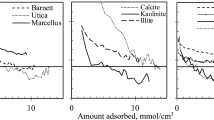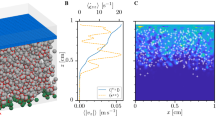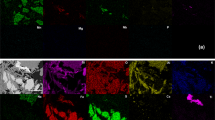Abstract
Despite kerogen’s importance as the organic backbone for hydrocarbon production from source rocks such as gas shale, the interplay between kerogen’s chemistry, morphology and mechanics remains unexplored. As the environmental impact of shale gas rises, identifying functional relations between its geochemical, transport, elastic and fracture properties from realistic molecular models of kerogens becomes all the more important. Here, by using a hybrid experimental–simulation method, we propose a panel of realistic molecular models of mature and immature kerogens that provide a detailed picture of kerogen’s nanostructure without considering the presence of clays and other minerals in shales. We probe the models’ strengths and limitations, and show that they predict essential features amenable to experimental validation, including pore distribution, vibrational density of states and stiffness. We also show that kerogen’s maturation, which manifests itself as an increase in the sp2/sp3 hybridization ratio, entails a crossover from plastic-to-brittle rupture mechanisms.
This is a preview of subscription content, access via your institution
Access options
Subscribe to this journal
Receive 12 print issues and online access
$259.00 per year
only $21.58 per issue
Buy this article
- Purchase on Springer Link
- Instant access to full article PDF
Prices may be subject to local taxes which are calculated during checkout





Similar content being viewed by others
References
Kerr, R. A. Natural gas from shale bursts onto the scene. Science 328, 1624–1626 (2010).
Cueto-Felgueroso, L. & Juanes, R. Forecasting long-term gas production from shale. Proc. Natl Acad. Sci. USA 110, 19660–19661 (2013).
Osborn, S. G., Vengosh, A., Warner, N. R. & Jackson, R. B. Methane contamination of drinking water accompanying gas-well drilling and hydraulic fracturing. Proc. Natl Acad. Sci. USA 108, 8172–8176 (2011).
Howarth, R. W., Ingraffea, A. & Engelder, T. Natural gas: should fracking stop? Nature 477, 271–275 (2011).
Vidic, R., Brantley, S., Vandenbossche, J., Yoxtheimer, D. & Abad, J. Impact of shale gas development on regional water quality. Science 340, 1235009 (2013).
Vandenbroucke, M. & Largeau, C. Kerogen origin, evolution and structure. Org. Geochem. 38, 719–833 (2007).
Clarkson, C. et al. Pore structure characterization of north American shale gas reservoirs using USANS/SANS, gas adsorption, and mercury intrusion. Fuel 103, 606–616 (2013).
Mastalerz, M., He, L., Melnichenko, Y. B. & Rupp, J. A. Porosity of coal and shale: insights from gas adsorption and SANS/USANS techniques. Energy Fuels 26, 5109–5120 (2012).
Thomas, J. J., Valenza, J. J., Craddock, P. R., Bake, K. D. & Pomerantz, A. E. The neutron scattering length density of kerogen and coal as determined by CH3OH/CD3OH exchange. Fuel 117, 801–808 (2013).
Gu, X., Cole, D. R., Rother, G., Mildner, D. F. R. & Brantley, S. L. Pores in Marcellus shale: a neutron scattering and FIB-SEM study. Energy Fuels 29, 1295–1308 (2015).
Wang, Y., Zhu, Y., Chen, S. & Li, W. Characteristics of nanoscale pore structure in northwestern Hunan shale gas reservoirs using field emission scanning electron microcopy, high-pressure mercury intrusion, and gas adsorption. Energy Fuels 28, 945–955 (2014).
Firouzi, M., Rupp, E. C., Liu, C. W. & Wilcox, J. Molecular simulation and experimental characterization of the nanoporous structures of coal and gas shale. Int. J. Coal Geol. 121, 123–128 (2014).
Aguilera, R. et al. Flow units: from conventional to tight-gas to shale-gas to tight-oil to shale-oil reservoirs. SPE Reservoir Eval. Eng. 17, 190–208 (2014).
Falk, K., Coasne, B., Pellenq, R. J.-M., Ulm, F.-J. & Bocquet, L. Subcontinuum mass transport of condensed hydrocarbons in nanoporous media. Nature Commun. 6, 6949 (2015).
Baihly, J. D. et al. SPE Annual Technical Conference and Exhibition (Society of Petroleum Engineers, 2010).
Behar, F. & Vandenbroucke, M. Chemical modelling of kerogens. Org. Geochem. 11, 15–24 (1987).
Siskin, M. et al. Composition, Geochemistry and Conversion of Oil Shales 143–158 (Springer, 1995).
Lille, Ű., Heinmaa, I. & Pehk, T. Molecular model of Estonian kukersite kerogen evaluated by 13C MAS NMR spectra. Fuel 82, 799–804 (2003).
Kelemen, S. et al. Direct characterization of kerogen by X-ray and solid-state 13C nuclear magnetic resonance methods. Energy Fuels 21, 1548–1561 (2007).
Orendt, A. M. et al. Three-dimensional structure of the Siskin Green River oil shale kerogen model: a comparison between calculated and observed properties. Energy Fuels 27, 702–710 (2013).
Collell, J. et al. Molecular simulation of bulk organic matter in type II shales in the middle of the oil formation window. Energy Fuels 28, 7457–7466 (2014).
Ungerer, P., Collell, J. & Yiannourakou, M. Molecular modelling of the volumetric and thermodynamic properties of kerogen: influence of organic type and maturity. Energy Fuels 29, 91–105 (2015).
Yiannourakou, M. et al. Molecular simulation of adsorption in microporous materials. Oil Gas Sci. Technol. 68, 977–994 (2013).
Mullins, O. C. et al. Advances in asphaltene science and the Yen–Mullins model. Energy Fuels 26, 3986–4003 (2012).
Sedghi, M., Goual, L., Welch, W. & Kubelka, J. Effect of asphaltene structure on association and aggregation using molecular dynamics. J. Phys. Chem. B 117, 5765–5776 (2013).
Okiongbo, K. S., Aplin, A. C. & Larter, S. R. Changes in type II kerogen density as a function of maturity: evidence from the Kimmeridge Clay Formation. Energy Fuels 19, 2495–2499 (2005).
Tissot, B. & Welte, D. (eds) Petroleum Formation and Occurrence (Springer, 1984).
van Krevelen, D. W. Coal: Typology, Chemistry, Physics, Constitution (Elsevier, 1961).
Bousige, C., Boţan, A., Ulm, F.-J., Pellenq, R. J.-M. & Coasne, B. Optimized molecular reconstruction procedure combining hybrid reverse Monte Carlo and molecular dynamics. J. Chem. Phys. 142, 114112 (2015).
Firouzi, M., Alnoaimi, K., Kovscek, A. & Wilcox, J. Klinkenberg effect on predicting and measuring helium permeability in gas shales. Int. J. Coal Geol. 123, 62–68 (2014).
Bažant, Z. P., Salviato, M., Chau, V. T., Viswanathan, H. & Zubelewicz, A. Why fracking works. J. Appl. Mech. 81, 101010 (2014).
Monteiro, P. J., Rycroft, C. H. & Barenblatt, G. I. A mathematical model of fluid and gas flow in nanoporous media. Proc. Natl Acad. Sci. USA 109, 20309–20313 (2012).
Pomerantz, A. E. et al. Sulfur speciation in kerogen and bitumen from gas and oil shales. Org. Geochem. 68, 5–12 (2014).
Melezhik, V., Filippov, M. & Romashkin, A. A giant palaeoproterozoic deposit of shungite in NW Russia: genesis and practical applications. Ore Geol. Rev. 24, 135–154 (2004).
Melezhik, V. A. et al. Petroleum surface oil seeps from a palaeoproterozoic petrified giant oilfield. Terra Nova 21, 119–126 (2009).
Kovalevski, V., Buseck, P. R. & Cowley, J. Comparison of carbon in shungite rocks to other natural carbons: an X-ray and TEM study. Carbon 39, 243–256 (2001).
Suleimenova, A. et al. Acid demineralization with critical point drying: a method for kerogen isolation that preserves microstructure. Fuel 135, 492–497 (2014).
Opletal, G. et al. Hybrid approach for generating realistic amorphous carbon structure using Metropolis and reverse Monte Carlo. Mol. Simul. 28, 927–938 (2002).
Jain, S., Pellenq, R., Pikunic, J. & Gubbins, K. Molecular modeling of porous carbons using the hybrid reverse Monte Carlo method. Langmuir 22, 9942–9948 (2006).
Ni, B., Lee, K.-H. & Sinnott, S. B. A reactive empirical bond order (REBO) potential for hydrocarbon-oxygen interactions. J. Phys. Condens. Matter 16, 7261–7275 (2004).
Bellissent-Funel, M.-C. Status of experiments probing the dynamics of water in confinement. Eur. Phys. J. E 12, 83–92 (2003).
Tomeczek, J. & Palugniok, H. Specific heat capacity and enthalpy of coal pyrolysis at elevated temperatures. Fuel 75, 1089–1093 (1996).
Savest, N. & Oja, V. Heat capacity of kukersite oil shale: literature overview. Oil Shale 30, 184–192 (2013).
Bhattacharya, S. & Gubbins, K. E. Fast method for computing pore size distributions of model materials. Langmuir 22, 7726–7731 (2006).
Rexer, T. F., Benham, M. J., Aplin, A. C. & Thomas, K. M. Methane adsorption on shale under simulated geological temperature and pressure conditions. Energy Fuels 27, 3099–3109 (2013).
Rexer, T. F. T., Mathia, E. J., Aplin, A. C. & Thomas, K. M. High-pressure methane adsorption and characterization of pores in Posidonia shales and isolated kerogens. Energy Fuels 28, 2886–2901 (2014).
Chen, C., Hu, D., Westacott, D. & Loveless, D. Nanometer-scale characterization of microscopic pores in shale kerogen by image analysis and pore-scale modeling. Geochem. Geophys. Geosyst. 14, 4066–4075 (2013).
Guo, X., Li, Y., Liu, R. & Wang, Q. Characteristics and controlling factors of micropore structures of the Longmaxi shale in the Jiaoshiba area, Sichuan Basin. Nat. Gas Ind. B 1, 165–171 (2014).
Klaver, J., Desbois, G., Littke, R. & Urai, J. L. BIB-SEM characterization of pore space morphology and distribution in postmature to overmature samples from the Haynesville and Bossier shales. Mar. Petrol. Geol. 59, 451–466 (2015).
Vandamme, M., Ulm, F.-J. & Fonollosa, P. Nanogranular packing of C–S–H at substochiometric conditions. Cement Concrete Res. 40, 14–26 (2010).
Mi, X. & Shi, Y. MRS Proceedings Vol. 1224, 1224-FF10-10 (Cambridge Univ. Press, 2009).
He, G., Eckert, J., Löser, W. & Schultz, L. Novel Ti-base nanostructure–dendrite composite with enhanced plasticity. Nature Mater. 2, 33–37 (2002).
Seewald, J. S. Organic–inorganic interactions in petroleum-producing sedimentary basins. Nature 426, 327–333 (2003).
Neuefeind, J., Feygenson, M., Carruth, J., Hoffmann, R. & Chipley, K. K. The nanoscale ordered MAterials diffractometer NOMAD at the Spallation Neutron Source SNS. Nucl. Instrum. Methods 287, 68–75 (2012).
NIST, Neutron scattering lengths and cross sections; http://www.ncnr.nist.gov/resources/n-lengths.
Plimpton, S. Fast parallel algorithms for short-range molecular dynamics. J. Comp. Phys. 117, 1–19 (1995).
Sun, H. Compass: an ab initio force-field optimized for condensed-phase applications overview with details on alkane and benzene compounds. J. Phys. Chem. B 102, 7338–7364 (1998).
Materials Studio Modelling Environment Version 6.1 (Accelrys, 2013).
Hinsen, K., Pellegrini, E., Stachura, S. & Kneller, G. R. nMoldyn 3: using task farming for a parallel spectroscopy-oriented analysis of molecular dynamics simulations. J. Comp. Chem. 33, 2043–2048 (2012).
Acknowledgements
This work was supported by the X-Shale project enabled through MIT’s Energy Initiative, with sponsorship provided by Shell and Schlumberger. Additional support was provided by the ICoME2 Labex (ANR-11-LABX-0053) and the A ∗ MIDEX projects (ANR-11-IDEX-0001-02) co-funded by the French programme ‘Investissements d’Avenir’ managed by ANR, the French National Research Agency. The authors thank M. Hubler (MIT) and J. Gelb (Carl Zeiss X-ray Microscopy) for providing the X-Ray Microscopy image of raw shale, and A. Saul, J. M. Leyssale, H. Van Damme and A. Archereau for fruitful discussions. The neutron scattering experiments were carried out at the Spallation Neutron Source, which is sponsored by the Scientific User Facilities Division, Office of Basic Energy Sciences, US Department of Energy, under Contract No. DE-AC05-00OR22725 with Oak Ridge National Laboratory.
Author information
Authors and Affiliations
Contributions
C.B., B.C., R.J.-M.P. and F.-J.U. designed the work. C.B. performed the simulations and data treatment. A.S. and A.E.P. performed the acid demineralization with critical point drying. A.S., A.E.P., C.M.G. and C.V.-G. measured the nitrogen and CO2 adsorption isotherms. C.B. and B.C. performed the scattering measurements with G.V., G.G., M.F. and C.W. as instrument scientists. C.B., B.C., R.J.-M.P. and F.-J.U. wrote the paper.
Corresponding author
Ethics declarations
Competing interests
The authors declare no competing financial interests.
Supplementary information
Supplementary Information
Supplementary Information (PDF 4494 kb)
Rights and permissions
About this article
Cite this article
Bousige, C., Ghimbeu, C., Vix-Guterl, C. et al. Realistic molecular model of kerogen’s nanostructure. Nature Mater 15, 576–582 (2016). https://doi.org/10.1038/nmat4541
Received:
Accepted:
Published:
Issue Date:
DOI: https://doi.org/10.1038/nmat4541
This article is cited by
-
Predictive Power of Theoretical Adsorption Models for Gases (H2, CO2 and CH4) in Overmature Kerogen
Arabian Journal for Science and Engineering (2023)
-
A review on the applications of nuclear magnetic resonance (NMR) in the oil and gas industry: laboratory and field-scale measurements
Journal of Petroleum Exploration and Production Technology (2022)
-
Computing inelastic neutron scattering spectra from molecular dynamics trajectories
Scientific Reports (2021)
-
Kerogen nanoscale structure and CO2 adsorption in shale micropores
Scientific Reports (2021)
-
Nanoscale 3D quantitative imaging of 1.88 Ga Gunflint microfossils reveals novel insights into taphonomic and biogenic characters
Scientific Reports (2020)



